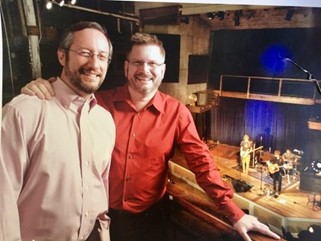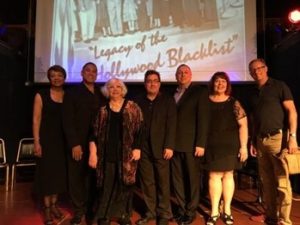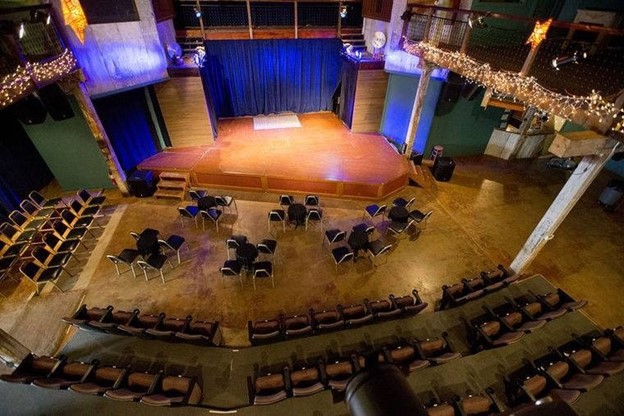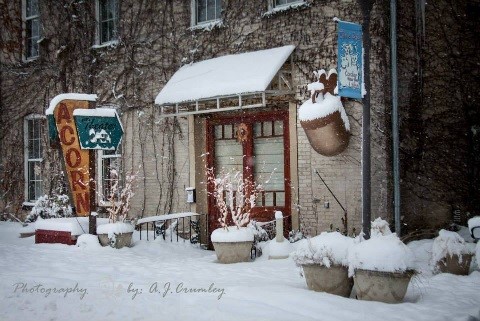Building a Theater

David Fink and Kim Clark
In 2001, my partner Kim Clark and I purchased a 20,000-foot former factory in the small town of Three Oaks, which is in Southwestern Michigan, with the intention of turning it into a live performance venue. The building was constructed in the late 1800s as part of the Warren Featherbone Factory where they made corsets using the cartilage of turkey feathers instead of whalebone, since it was more comfortable, lasted longer, and didn’t smell as bad. When we bought the brick structure, there was a hole in the roof where rain and snow were rotting the wood on the second floor. There were many bricks missing. There was no paved street in front of the building. Kim saw the potential and acted as general contractor and visionary.
Partnership and Planning
 My 22-year-long relationship with Kim Clark began in 1995. Kim had a larger-than-life personality. He was a writer and producer. He was an ordained minister. He was a candidate for the US Congress. He taught college, (DePaul University in Chicago) among other things. For several years, he headed the writing programs nationally for Second City. He won a Midwest Emmy award.
My 22-year-long relationship with Kim Clark began in 1995. Kim had a larger-than-life personality. He was a writer and producer. He was an ordained minister. He was a candidate for the US Congress. He taught college, (DePaul University in Chicago) among other things. For several years, he headed the writing programs nationally for Second City. He won a Midwest Emmy award.
When we first started dating, Kim owned a farmhouse in Union Pier, Michigan that he was turning into a bed-and-breakfast. His business partner wanted out before they opened, so I bought his half, with the agreement that I would only be a financial partner. At the time, I was president of a manufacturing company. The seven-guest room B&B was gorgeous and charming, with jacuzzi tubs and fireplaces in the guest rooms and a lovely, shared dining room. Kim was the general contractor for two years of renovation. We operated the business for two more years before I wanted out. I didn’t enjoy my weekends, as I found them more stressful than my regular job. At the inn, one must be nice to strangers in the mornings. It’s uncivilized.
In 1999, Kim Clark and I sold our bed-and-breakfast in Union Pier and decided to use the proceeds to open a live performance venue. We had already produced a couple shows in Three Oaks, MI during an annual event called Art Attack, and sold out every show, bringing in artists you wouldn’t normally find in a small farm town. Our first show had groups known in the art scene of Chicago including people from 500 Clown, Local Infinities, Neofuturists, and David Sedaris. In 2001, we closed on the building, Kim acted as general contractor and turned what was, at the time of purchase, a printing company, into a hip venue.
Construction and Development

When we closed on the building, the place looked terrible, so for what I thought was a bargain price, we got a building that had about 20,000 square feet of space. Kim removed the rotted wood and cleared the building so that the only thing you could see when you entered was, near the far end, a toilet emerging from the floor. Kim encircled the toilet with opaque plastic for modesty and eventually created a stage and seats and added some basic lights and sound. He kept the bones of the factory visible. You would see all the beams and structure. There is a cement floor with radiant heat underneath. Cooling was more expensive than heating the space, and we bought a large used industrial air-conditioner. The ceilings were high, with reinforced beams, and the building was stable without pillars blocking sight lines, allowing a huge open space for performances. We also built an apartment with guest rooms for friends and performers. We wanted to allow the place to be a hothouse for creativity.

Legendary theatre organ amidst construction
Due to the thick brick walls and the high ceilings, the sound was bright and clear. We left a lot of empty space between the permanent seats which were right in front of the stage and the stage itself. We also had lots of empty space on the sides. We could configure this for each show depending on the needs. It could be empty for dancing, or have rugs for children’s seating, or it could be filled with banquet chairs. We could add cabaret tables or larger tables. We could even add a runway. We wanted the space to be as flexible as possible. On both sides of the stage, high and low, were pipe organ chambers filled with pipes. There were also instruments around the room which connected to the organ console. This huge 1930s Barton theater organ was epic in size and sound. Along with the traditional pipe organ sounds, it had brass and a piano and toys like whistles and horns. It had lots of percussion, including roll and crash cymbals. People’s heads exploded when they saw and heard this monstrosity.
The balconies on both sides of the stage were deep. They were usually empty during shows but, on occasion, people would sit or stand there. Once in awhile we have had private parties for sponsors there. And, at times, we would put out mattresses. We regularly had a burlesque troupe who would have 20 or more sleeping over. Or a theater company having a retreat would have company members sleeping everywhere. The mattresses were used more times than you would imagine.
The most popular facet of the theater was the huge women’s restroom. When we started the construction, my parents gave us a little money and my mother gave me a paper with her wishes for the women’s bathroom. She wanted women to never have to wait in line, so we built 6 stalls instead of the required two. She also said that it should be attractive looking, have full doors on the stalls, and little counter space, as women are messy and would leave trash if we provide a place. Vindictively, she said that she wanted a tiny men’s room, so that men would always have to wait in a long line. That is the only item on her list with which we did not comply. We had original art displayed in the women’s room and eventually made the men’s into a sort of art gallery. It was never as nice as the women’s, but it had character.
Once, during intermission, an audience member told me that he couldn’t wait until we could afford to fix the place up. I asked what he meant. He said, “You know, add carpet and drywall.“ I told him that the look was a choice. We were not trying to hide the old factory but showcase the cool bones of the building. He shrugged like he didn’t believe me.
 Near the entrance, we had lots of empty space that we would periodically reconfigure. At first, it was a lobby for the audience to wait until doors opened. We later used part of the lobby as an art gallery, specialty beer and wine show, and later a lounge with coffee. We sometimes had small shows there, or classes. We even had a piano there.
Near the entrance, we had lots of empty space that we would periodically reconfigure. At first, it was a lobby for the audience to wait until doors opened. We later used part of the lobby as an art gallery, specialty beer and wine show, and later a lounge with coffee. We sometimes had small shows there, or classes. We even had a piano there.
The Acorn felt warm and cozy. The atmosphere was intimate. Many performers said it was their favorite place to perform because of the superior sound and intimacy. An amazing fiddler named Mark O’Connor performed a solo violin concert without amplification and everyone could hear every note, forte to pianissimo. The first time an opera singer sang on our stage, not in a show but just talking to me about the possibility of performing opera at The Acorn, I told him he would have to sing softer. Even though he was not using a mic, he was too loud for the room.
Cabaret Gives a Boost
In 2003, we had an invitation-only show that we thought would show the community our vision for entertainment. Cabaret singer and humorist Colleen McHugh played for an audience of influential and helpful people from the area including local mayors and council people, hotel and inn owners, and others who were helpful to us and deserved a gift. People loved Colleen, the rustic, industrial, unfinished look of the room, the clear sound, and the intimacy. We had 99 fixed seats and could add banquet chairs to create a capacity of 260. We would often reduce the number of seats to add bistro tables up front to create a nightclub look.
In our first year or so, we had several cabaret performers including Justin Hayford, The Weird Sisters, Beckie Menzie and Tom Michael, Colleen McHugh, Rob Lindley, Roxy Bellows (Pat Musker), Sara Davis, Bunny Fisher, and David Lahm and Judy Kreston paying tribute to David’s mother Dorothy Fields.
Seeing people sneak in alcohol, mainly wine, convinced us to seek a liquor license. The bar eventually doubled our revenue. In order to attain the license, we were told by the liquor commission that we had to get the village council to approve a permit for topless activity, in case, somehow, a nipple became visible on our stage. Fortunately, Kim and I had a good reputation, and we were granted permission and given the license.
 A cabaret show that was one of our best received was produced by Carla Gordon entitled Blacklisted. The songs and story had political nuances that were historic and, sadly, current. The singers were some of the finest in Chicago cabaret. The musicians were top-notch. The show belonged on a stage and utilized our projection system, giving it a more theatrical feel and adding to the weight of the themes in the show.
A cabaret show that was one of our best received was produced by Carla Gordon entitled Blacklisted. The songs and story had political nuances that were historic and, sadly, current. The singers were some of the finest in Chicago cabaret. The musicians were top-notch. The show belonged on a stage and utilized our projection system, giving it a more theatrical feel and adding to the weight of the themes in the show.
Celebrity is an odd phenomenon. I loved presenting a working performer, but I was not so fond of stars. I was not big on fawning. One working actor, who was also a celebrity, was Tom Wopat, who was famous for starring in Dukes of Hazzard, a silly light 80s TV comedy. Tom has Broadway credits for performing musical theater and he came to The Acorn Theater with a cabaret show. He started doing musical theater as a young man in Kalamazoo, Michigan, about an hour from Three Oaks. His fans were rabid. A woman flew in from Germany to follow him to all his gigs. People brought all sorts of car parts, many large, including a hood and a dashboard, for Tom to autograph. One woman brought a wrapped gift of a framed peace sign. People were in awe of his stardom. Tom, on the other hand, was down to earth, friendly to his fans, often disarmingly so. When people were tongue tied, he would smile, offer his hand, and say, “Hi. I’m Tom.” If they remained silent, he would ask their name in a friendly tone. Before the show, in the green room, I asked Tom if these awkward interactions were common. He said that if you are in a pop culture phenomenon, you must embrace it. As an outsider, it appeared uncomfortable, but he seemed to handle his fame well.

Through the years, we had many cabaret shows with many themes. Some of the singers, like Laura Freeman, Colleen McHugh, and Jane Blass, performed in new musicals, usually staged readings on steroids.
When the Acorn Theater eventually got its not-for-profit status, some benefit performances gave us a boost. The first Acorn benefit featured a concert by The Queen of Chicago Cabaret, Denise Tomasello. Joan Curto followed the next year. Anne Hampton Calloway also performed at a fund-raising event.
Other cabaret artists we hosted not mentioned above include Hilary Ann Feldman, Foiled Again, Luba Mason, Sharon McNight, Karen Mason, Libby York, Frank D’Rone, Lesley Gore, Spider Saloff, Susan Werner, Michael Holmes, Matt Alber, Tom Goss, Judith Owen, Steven Brinberg as Simply Barbra, Jean Scherkenbach, and Bonnie Koloc and many more. Many artists we hosted could fit in this category even though they performed bluegrass, jazz, comedy, and other genres but were essentially cabaret.
Business Model and Goals
When we opened in May of 2003, we were in our early 40s. At the time, we seated 260 at capacity. Our business plan was to make enough money to cover our expenses and nothing more. We thought we could have one-to-two person shows every Friday and Saturday night and charge $15 per ticket — pay the performers $300-400 a night and sell 100 ticket per show. It seemed like a reasonable plan.
We had lots of goals. We wanted everyone in the building to be comfortable being themselves, performers as well as audience members. We wanted to bring a big world to a small town. We wanted to be a default community center. We wanted artists to have a place to create comfortably. We were enthusiastic and naive.
to a small town. We wanted to be a default community center. We wanted artists to have a place to create comfortably. We were enthusiastic and naive.
Kim created the space, and I filled it. I booked the shows and tried to get audiences to attend. What I didn’t realize was that I would become a sort of public figure in this small town. Because I did all sorts of things to get press and I attended pretty much all the performances, and Kim or I would perform a curtain speech, I was approachable, and people felt like they knew me. This was uncomfortable for me being naturally quiet, wry, and basically shy, and subject to stage fright. People still remind me how nervous I looked giving those early curtain speeches.
Through the years, we have been written about in the New York Times, USA Today, Washington Post, on four shows on HGTV, and regularly on local radio, PBS, newspapers, and other public forms of publicity. We were also on WGN TV, WGN radio, a couple NPR affiliates, and in Chicago newspapers and magazines. This, as well as social media, were all used to let people know we had high-quality professional acts and, hopefully, get people to attend shows. Booking shows is pretty easy. Getting people to attend is pretty hard. Sometimes I’d book a big national act just to get the attention and not to make money. Every time we had a sell-out show and turned people away, for a period of time, people would buy tickets in advance.
We grew organically. People soon tired of one and two person shows. We booked some bigger acts and needed to add more sound and lights. Then we had to raise our prices.
Intimate Theater, Variety and Live Music
The first official show at The Acorn Theater was Memorial Day weekend of 2003. Amy Seeley performed her one-person show entitled Amy Seeley and the Moline Madman. Amy portrays herself as a preteen and going through her life with her gruff, funny, crude racecar driver father. The play is lovely and funny, and sad and heartfelt, everything we wanted on our stage. We brought the show back in 2014 for the Acorn anniversary.
A group of European-style clowns performed a mime show. One of the pieces involved choosing an attractive young woman from the audience. In one performance, they chose a lovely, well-endowed young woman who seemed thrilled to go on stage. Once chosen, she was taken on a ’date’ with one of the clowns, who was trying to woo her. It was all innocent and fun, but it was clear early on that this woman had matured physically at a young age and was much younger than she appeared. She was good natured but awkward. Clearly, she had never yet been on an actual date. I watched her family in the front row laughing their butts off. I was glad they weren’t angry, as I watched in horror and embarrassment. Once the bit started, there was no way out of it except for going through it. On their way out, the family told me that she was twelve years old and that they all thought it was a riot. Later in 2021, I talked with a friend about that memory, and she told me that she was that little girl. As a child, she had been in theater and improv and loved the experience. No damage done, thank goodness.
A talented African American actor/writer named James T. Alfred performed a one-man show. Because of his tough yet handsome looks, he was always being cast as a heavy, so he wrote a show to show off his range as an actor. If casting directors couldn’t see his potential, he would have to show them. After his justly well-received performances, he told me this was the first time he ever performed this piece in front of an all-white audience. People laughed and enjoyed the piece but laughed in different places than he was used to from past shows. A piece about being a substitute teacher when one of the kids had an ‘accident’ in his pants had his normal audience rolling on the floor with laughter while the white audience looked uncomfortable and a bit horrified. And there were other moments where the audience wouldn’t stop laughing and it was a moment that never had laughs before. As a gifted performer, he was able to adjust each show as needed.
There was a music and comedy variety show called Cabarah. After the show, the cast hung out and had a few drinks with each other. In that group were a Muslim, a Jew, an evangelical, and a Catholic. Talking about our upbringings and the contrast between the culture of our family and the culture of live performance was fascinating. It seems all of us were breaking some sort of rules and all of us were ok with that. We all benefitted from hearing about each other’s journeys. One of the performers was a comedian who went on to lots of high-profile shows. His name is Kumail Nanjiani.
I found certain shows, no matter how talented the artist, were hard to sell. I tried not to use the words ‘poetry’ or ‘spoken word’ or ‘jazz’ or ‘harmonica’ unless necessary. It was better to focus on the bio and the artist’s prestigious venues they played, famous collaborators, etc. Off the top of my head, I can think of three amazing jazz concerts that had small houses but deserved huge crowds. The bands were Rudder, Crawl, and Snarky Puppy. Snarky currently has 5 GRAMMYS and a loyal following.
People often have a limited idea of jazz. We had a tribute to Harold Arlen. A couple showed up a day early. I offered them free tickets to the show since they made the drive. They inquired about the show and, when told it was jazz, said they dislike jazz and departed. Harold Arlen, whose music they came to see, wrote jazz.
I booked a nationally popular band. Although their shows sold out and were great, to me it was obvious that a crucial member of the band was drunk and that it was impacting his performance. When the manager contacted me to book another date, I declined. He was incredulous and asked why. My first reason was that their contract was ridiculous for our venue. It was written for a stadium or arena with vast financial and staff resources. The manager told me to cross off and initial any changes I see fit, which I did. The other issue was the drinking. I said that I was afraid the band member wouldn’t be able to get through another gig. The manager asked if I would book the band if he promised this performer wouldn’t drink any liquor until after the show. I agreed and signed the contract. After that gig, I went to the green room and thanked the band for a great show. The musician looked at me, told me he lived up to his promise, and started chugging vodka out of a handle bottle. I can’t fault him. He did keep his word.
Although booking shows was nowhere near as difficult as getting audiences to buy tickets and show up, people were constantly telling me acts to book. They assumed anyone they liked would be a hit. People never gave a thought to the finances involved. I remember a customer walking out of a great jazz concert by the Steve Evans Quartet. Tickets were only $15 for a world-class set of musicians. The customer told me that the show was great and that he didn’t expect anything that professional since the tickets were so cheap. I then asked if he would have paid more for his tickets. He replied that he wouldn’t have paid more since he didn’t know the band but, after hearing them, he decided it was a disservice to charge so little for an act of this caliber. I felt like I just couldn’t win.
anyone they liked would be a hit. People never gave a thought to the finances involved. I remember a customer walking out of a great jazz concert by the Steve Evans Quartet. Tickets were only $15 for a world-class set of musicians. The customer told me that the show was great and that he didn’t expect anything that professional since the tickets were so cheap. I then asked if he would have paid more for his tickets. He replied that he wouldn’t have paid more since he didn’t know the band but, after hearing them, he decided it was a disservice to charge so little for an act of this caliber. I felt like I just couldn’t win.
I booked Richie Havens a couple of times. He was gentle and friendly and nice. He stuck around after each show for as long as audience members wanted to talk with him, take photos, or just share space with him. I mentioned to him that I loved the way he interacted with his fans for so long. He said, “This is my third set.” Before one of his shows, at dinner in our apartment above the theater, he spent a lot of time playing with my Sheltie. He said that he would love to have a dog like that. When I inquired why he didn’t get one, he replied, “Because I couldn’t bear to lose it.” His second time at the theater, he and I were hanging out in the lobby. He started the most interesting story about playing at a club in the 60s and after his set, while he was in the men’s room peeing, someone started talking to him, which annoyed him until he realized it was a famous musician. I think maybe Bob Dylan. Bob then invited Richie to join him and his friends (who were all equally famous musicians whose names I don’t recall). Richie then looked at the ceiling of the lobby of the theater and started asking me about it. I tried to get him to continue his fascinating story, but he was only interested in the ceiling. Since his prior visit, we changed the ceiling from a light fixture amid drywall to a light fixture in the center of brightly colored drooping fabric, like a circus tent. Once his mind shifted, that was it. My experience with Richie Havens was that he had great starts and middles of stories, but you never got to hear the end. His mind drifted somewhere else.
I also booked a folk singer who had some huge hits. I picked her up at Midway airport and found her in a wheelchair. I told her I was sorry and that I would bring the car to the door. She said that she doesn’t really need the wheelchair but that it gets the airlines to treat her better. I was frightened about having to take care of her for a couple of nights. She screamed high maintenance. I was warned that she loved to be late for everything. This worried me because I had her booked on a tv show in the morning and tv is not forgiving regarding time. She was punctual. She just used tardiness for extra attention. During her concert, she noticed a camera in the audience to the right of the stage. She stopped mid-song and told the person to move to the center of the theater since she only wanted to be shot full-faced. People laughed and thought she was playing. But she would not continue until the guy moved to the center of the audience and then she played like nothing had happened.
Several times we booked storytelling competitions on Friday and Saturday. These shows were run by WNEP Theatre from Chicago, who did a lot with us in our first few years. This event became a popular annual event. Friday night was called The Maelstrom and involved improvised stories based on suggestions from the audience. The audience voted on the winner. Saturday was The Skald and had six tellers compete with stories seven-minutes max. We had judges, ideally public people who could help the tellers, who would select the winner. The first time we did this program, someone told me they brought their teenagers to the Friday show. The young people had NO interest in hearing stories. However, they left The Acorn inspired and had great conversations with the parents in the car, since the stories opened an opportunity for discussion. The teens insisted they return the next night for The Skald and attended this show annually.
 One year, we had a huge thunderstorm, and the venue lost all power. Since storytelling requires so little tech, we filled the edge of the stage with candles and brought a bunch of flashlights to the ticket desk. We performed the show to an appreciative audience who loved the experience and gave a huge ovation. The following night, we still had no power, so we moved the show outdoors and did it for free in a park. I think we had a more local crowd than usual, many dressed more for farming than for attending the theater. Again, it was very well received and a lot of fun.
One year, we had a huge thunderstorm, and the venue lost all power. Since storytelling requires so little tech, we filled the edge of the stage with candles and brought a bunch of flashlights to the ticket desk. We performed the show to an appreciative audience who loved the experience and gave a huge ovation. The following night, we still had no power, so we moved the show outdoors and did it for free in a park. I think we had a more local crowd than usual, many dressed more for farming than for attending the theater. Again, it was very well received and a lot of fun.
Dealing with adversity made shows memorable. Once Cathy Richardson forgot to bring a capo and asked if anyone in the audience had one. No one did so she used a sharpie and rubber band. That is a show everyone recalls.
We tried lots of different recuring programming. We had monthly big band dances and lessons. We had classes in flamenco, line dancing, and other forms of dance. We had great open mics. We had Tuesday night curated local musicians perform with no cover fee to attend. We had Thursday night nightclub with themes, dancing, music videos, and a gay and gay-friendly crowd. Lots of women preferred the gay night to feel safe and relaxed. We even had a few Burning Man themed events. We tried a monthly series of themed Sunday music brunches.
I was proud that this versatile space was used for community events. We had weddings (I officiated one of them), memorials, nonprofit meetings, charity events, and an annual Christmas gathering for the community produced by a nonprofit called Fotofest with great entertainment and food and it was free to attend for the community. We wanted kids to feel that going to the theater was a treat and not a chore.
Peter Yarrow, of Peter, Paul, and Mary told me that The Acorn embodied why he played folk music. He said that it was the best place for creating community. He played folk music for this reason. He let us put his quote on the front page of our website. He first played on a bill with his daughter’s duet, Bethany and Rufus. Peter made sure they sounded as good as possible and then sang backup vocals with them in the first set. The second set was all his with them singing backup. I realized he was giving his daughter the gift of his audience. I loved him for that. Another time, when he was performing

Jeff and After Dark award-winning Billings
“Puff the Magic Dragon,” Alexandra Billings entered the building. She was performing an often dark and intense and deeply personal one-woman autobiographical show called Before I Disappear and was going to start rehearsing it that night. When she felt the magic of the room and heard a song that was meaningful to her, she started to cry. She felt like everything was happening as it should. She was in a beautiful and safe space.
One day in 2018, when I went into the apartment I shared with Kim, I found his lifeless body on the floor. I called 911 and they proceeded to take care of their business. They had to carry his corpse down the stairs and out to the ambulance. The band Miles Nielsen and the Rusted Hearts were performing that night and were all in the green room where they would see the unpleasant sight of the EMTs with Kim. I didn’t want them to know what was happening, so I came down and acted friendly and distracted them until the task was complete, Miles’ dad Rick Nielsen, from the band Cheap Trick, was there for the first time, so I got to meet this rock legend. I did all I could to make it seem like any other gig at the Acorn. That was my best performance ever.
One of the biggest challenges we faced was demonstrating we were a professional operation. Because we were in a small farm town, people assumed we would only have bad amateur shows. To counter this, and to get extra press and prestige, we booked several famous performers:10,000 Maniacs, American Idol finalists (Crystal Bowersox, Casey Abrams, Lee DeWyze, Kris Allen, and Matt Giraud), BoDeans, The Buckinghams, Alexandra Billings, Peter Asher, Carolina Chocolate Drops, Cowboy Junkies, Cracker, Jeff Daniels, Kim Brickman, Dan Tyminski Band, Iris DeMent, Tom Dreesen, Lesley Gore, Nathan Gunn, Richie Havens, Ides of March, Iris, Jefferson Starship, Bonnie Koloc, Albert Lee, Howard Levy, John Mayall, Melanie, Maria Muldauer, Shawn Mullins, Kumail Nanjiani, Alice Peacock, The Platters, Poi Dog Pondering, Leon Redbone, Rusted Root, Corky Siegel, Todd Snider, Pamela Stanley, Judy Tenuta, Daniel J Travaniti, Jeff Tweedy, Louden Wainwright III, Tom Wopat, Peter Yarrow, among others.
My association with the Acorn ended in 2022. With the loss of my partner and the prospect of additional personal projects, the theater was sold to the nonprofit we had been renting to since 2015. The theatre continued operation as the Acorn Center for the Performing Arts.
As the song goes, “It was only a paper moon, sailing over a cardboard sea.” But through the developmental years, it seems a lot of people did believe in The Acorn.
Editorial Note: Kim and David were known as producers of festivals and shows before becoming theater owners. As theater owners, they functioned more as presenters who hosted productions already developed. Please see our Spotlight article on Tommy Hensel who advocated for theater owners hosting cabaret. The Acorn was exemplary in doing just that.
-by David Fink





